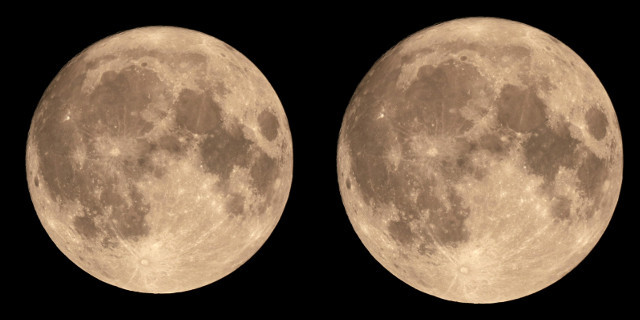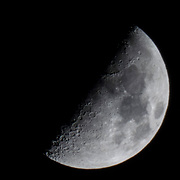One think you'll hear about a lot these days is the amazing Super Moon.
In the last few years particularly, the popular media seem to have latched on
to this amazing astronomical spectacle, and made it their mission to let us
know about every upcoming Super Moon, and to tell us to be sure to go outside
and marvel at the sight.
While I'm obviously glad to see the mainstream media encourage an interest
in astronomical events, the problem here is that they have got it completely
wrong. As an astronomical spectacle, the Super Moon simply doesn't exist — it
is essentially a hoax which journalists use to fill space and get clicks.
Which is tragic, because there are plenty of real astronomical things
going on which they could, and should, be telling you about.
The Super Moon Hoax
The Super Moon, promoted as a spectacular phenomenon by the mainstream
media, is a hoax. But, like many hoaxes, it's based on a grain of truth.
The truth here is that the Moon does, in fact, change size. Of
course, it doesn't really grow and shrink, but because its orbit is elliptical,
its distance from the Earth changes, and this makes its apparent size in the
sky change. So, there will be times when it is larger than
average; and sometimes this will coincide with a full Moon. This is
what the media calls a Super Moon.
The problem is the amount of change which we can see. While the media
use phrases like "amazing supermoon", and "one of the most spectacular
sights you could ever hope to see", the reality is that there's almost no
way you could see this in real life.
Of course many people have seen the Moon looking huge, much larger than
average — like 50% larger than normal. This will happen when the Moon is
close to the horizon; what you're seeing is actually the
Moon Illusion. This is purely
an optical illusion, and it happens with any state of the Moon, regardless
of whether it's "Super" or not.
On the Statistics page you will find information on the
Sizes of the Sun and Moon; and the
Moon Data page displays detailed
information on the Moon's key dates. To summarise, the Moon's apparent
size when directly overhead varies from 0.497° to 0.569°, with an average
around 0.530° (apparent sizes are measured as angles). This means that at
largest, the Moon is about 7.2% larger than average. And 7.2% is
just paltry. Calling this "Super" is absurd.
So yes, it's true that a full Moon can be larger than average; the problem
is that there's almost no way that you could see this with the naked eye.
The picture here shows the difference between an average Moon and a
"Super Moon":

A full moon and "super moon". Spot the difference.
Seeing these side-by-side on your screen, you can probably see the difference
quite easily — particularly when you look at the size of the black borders
around the two Moons. But if you imagine seeing these separately, a month apart,
it should be clear that the difference is just too small to observe without
measurement.
If you want to known when the next "super" Moon is happening, you can find
it with our Moon Calendar. Just
look for a date when the full Moon coincides with perigee.
Media Shame
Here are some typical examples of the media's supermoon rubbish:
If you go outside at night on 13/14 November, you might get to enjoy
something quite spectacular. You will see an amazing supermoon up in
the night sky, which means the Moon will be very big and bright.
This is just false — no, you won't see an amazing supermoon, and the
Moon won't be very big and bright; or at least not noticeably more
so than usual. The
Moon Illusion complicates
this, but you can see that any time there's a full Moon.
HAVE you ever seen a supermoon? If not you are missing out on
one of the most spectacular sights you could ever hope to see.
Wrong; it looks just like any other full Moon.
Supermoons are a rare type of full moon. They appear up to 14% bigger
and 30% brighter than normal. While the full moon rises about
once per month, supermoons can only occur a few times per year — max.
Wrong again: the "super" Moon is 7% bigger than average, not the
14% clearly implied here. Also the statement that "supermoons can only
occur a few times per year — max" is just strange; given that there are only
12 or 13 full Moons in a year, saying that "a few" of them are supermoons
implies a high frequency of supermoons.
Sometimes the BBC, despite their breathless enthusiasm, make a genuine
effort to get the facts straight:
To observers, the Moon appears about 7% larger and 15% brighter,
although the difference is barely noticeable to the human eye.
This is actually correct; although it contradicts the whole tone of
the article, and indeed the point of the article even existing. It also
directly contradicts the opening statement "... when the
Moon appears larger and brighter in the sky".
The Moon Illusion
The Moon Illusion is a very well-known and much-studied optical illusion
which causes the Moon (whether full or not) to appear enormously large
when it is close to the horizon. The Moon Illusion has nothing to do
with the actual size of the Moon in the sky; it is purely an optical
illusion.
The problem is that when people hear about a supermoon, they will tend
to go out and look at the Moon — usually right after it rises, when it is
close to the horizon. The Moon Illusion then makes it look huge, which
reinforces the idea that the supermoon is real. In reality, though, this
is easily debunked:
- Look at the Moon just a few hours later, when it's up in the sky,
and its size will be back to normal.
- Wait for the next full Moon, or any other full Moon, which is not
"super", and you will see exactly the same thing.
Proving It
The Moon Illusion is very convincing, and really quite spectacular —
the Moon looks massively bloated, and dominates the landscape. However, it
is purely an optical illusion. You can prove this quite
easily, any time the Moon is reasonably close to full:
- Go outdoors when the Moon is very close to the horizon; near the full Moon,
this will be just after sunset. The Moon should be close to recognisable
objects, like trees, buildings, hills, etc.
- Observe that the Moon looks huge. Take a picture of the Moon;
if your camera has a zoom, zoom all the way in.
- Wait a few hours, until the Moon is quite high in the sky.
- Observe that the Moon looks "normal sized". Take another picture of
the Moon; use the exact same zoom settings as before.
- Load both pictures on to your computer; as you place them side by side,
you will see that the Moon is the same size in both pictures.
This experiment proves that the apparent huge size of the Moon when
it was low is purely caused by the way your brain interprets the scene.
If it was caused by atmospheric refraction, or some such external thing,
then the camera would have seen and recorded the same effect.
Wikipedia's articleMoon illusion
An article on the Moon Illusion, which makes the Moon appear very large when close to the horizon. (Wikipedia)
on the
Moon Illusion describes it in more detail.
Genuine Sky Spectacles
As we said in the introduction, it's tragic that the media are putting
such effort into peddling garbage like the "Super Moon" when they could
be telling you about all kinds of real astronomical phenomena that you could
easily be observing. So, like what? Well, an eclipse, obviously! But
in between eclipses, there are plenty of other things to see in the sky.
Here are some ideas.
The Moon!

The half Moon,
about a week before Full Moon.
The Moon is awesome! Yes, certainly go out and look at it when it's
full — don't wait for the media to be blathering about super moons.
Use binoculars, take pictures, go wild! A picture of the full Moon
rising beside some Earthly scene, like trees or buildings, could be
amazing — but bear in mind that if you want it to look as big in a
picture as it does to your eye, you will need a very long telephoto lens.
Better than the full Moon, though, is the half Moon — specially through
binoculars or a telescope. About a week before the full Moon, go outside
on a clear night; after sunset, the half Moon should be high in the sky.
With the sunlight slanting across the lunar surface — as opposed to
shining straight down on it — the surface features are thrown into
amazing and spectacular relief. Check it out for yourself!
Jupiter
Another one for binoculars — check it out when the planet is
reasonably high above the horizon after dark. Take a good look and you
should see up to four sharp points of light near it — those are
Moons of Jupiter. In fact they're the Galilean Moons, which Galileo
used to show that the Earth isn't the centre of everything.
Meteor Showers
Meteor showers can be spectacular events to see, though be prepared
to hang out after midnight, and have a bit of patience. There are plenty
of online guides to the 11 major meteor showers in a year, so there are
lots of opportunities to see this beautiful spectacle.
Sunspots
This one involves looking at the Sun, so
eye safety is paramount; using a
solar projector is
probably the best way to go. With this set up, you should be able to see
sunspots quite easily, at times of significant solar activity.
Unfortunately, at the time of writing (2018) the Sun seems to be entering
a particularly quiet phase. However, there are still occasional sunspots,
and even at the quietest time there can be large areas of solar activity.
And of course the quiet period won't last forever. So set up your
projector!
And More!
There are so many astronomical events that can easily be seen by amateurs
that there's no way to list them all here. However, a quick search for
back yard astronomy, or binocular astronomy, will turn up many, many
inspirational ideas, and sources of information.

